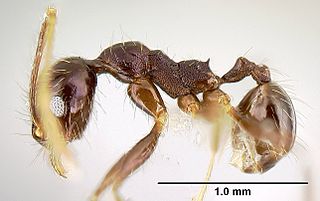
Pheidole is a genus of ants that belongs to the ant subfamily Myrmicinae. The genus is widespread and ecologically dominant. It probably includes more than a thousand species. The genus first evolved in the Americas, eventually spreading across the globe.
Barry Bolton is an English myrmecologist, an expert on the classification, systematics, and taxonomy of ants, who long worked at the Natural History Museum (London). He is known especially for monographs on African and Asian ants and for three encyclopaedic global works, including the Identification Guide to Ant Genera (1994), a full catalogue of ant taxa, and a synopsis and classification (2003). Now retired, Bolton is a Fellow of the Royal Entomological Society and Myrmecologist, Biodiversity Division, Department of Entomology, Natural History Museum, London.

Pheidole purpurea is a dimorphic species of ant found in Mexico and Central America. The species shows considerable variance in physical characteristics based on location, though some variance exists even within small populations. Some populations display a metallic, purple sheen.

Pheidole megacephala is a species of ant in the family Formicidae. It is commonly known as the big-headed ant in the USA and the coastal brown ant in Australia. It is a very successful invasive species and is considered a danger to native ants in Australia and other places. It has been nominated as one of the hundred "World's worst" invaders.
Pheidole psilogaster is a species of ant in the genus Pheidole. It is distributed across Mexico, Costa Rica, and Nicaragua.

Chimaeridris is a small genus of ants in the subfamily Myrmicinae. The genus contains two species known from tropical Asia. Their unique hook-shaped mandibles and similar appearance to Pheidole minor workers raises the possibility that the genus is a slave-maker of Pheidole ants or a specialized predator.
Pheidole barreleti is a species of ant in the subfamily Myrmicinae. It is found in Sri Lanka.
Pheidole ceylonica is a species of ant in the subfamily Myrmicinae. It is found in Sri Lanka.
Pheidole gracilipes is a species of ant in the subfamily Myrmicinae. It is found in Sri Lanka.
Pheidole horni is a species of ant in the subfamily Myrmicinae. It is found in Sri Lanka.
Pheidole latinoda is a species of ant in the subfamily Myrmicinae. It is found in India and Sri Lanka.
Pheidole malinsii is a species of ant in the subfamily Myrmicinae. It is found in India, Sri Lanka, and China.
Pheidole nietneri is a species of ant in the subfamily Myrmicinae. It is found in Sri Lanka, and China.
Pheidole noda is a species of ant in the subfamily Myrmicinae. It is found in Indonesia, Bangladesh, India, Taiwan, Thailand, Vietnam, Sri Lanka, Japan and South Korea.
Pheidole pronotalis is a species of ant in the subfamily Myrmicinae. It is found in India, and Sri Lanka.
Pheidole rugosa is a species of ant in the subfamily Myrmicinae. It is found in Sri Lanka.
Pheidole spathifera is a species of ant in the subfamily Myrmicinae. It is found in Asian countries.
Pheidole sulcaticeps is a species of ant in the subfamily Myrmicinae.
Pheidole templaria is a species of ant in the subfamily Myrmicinae.




